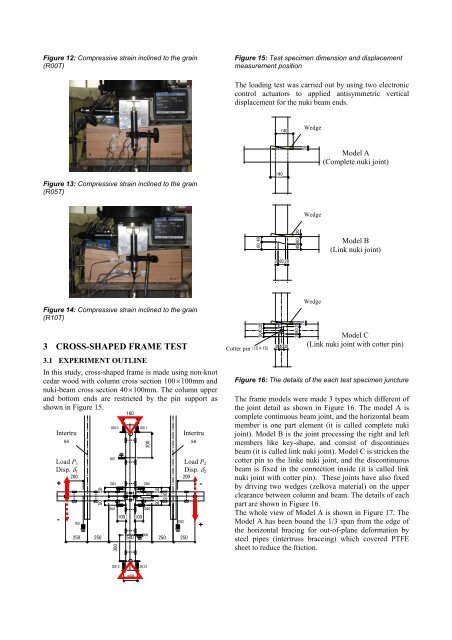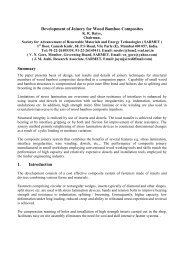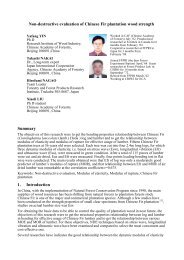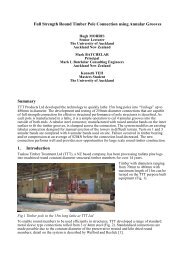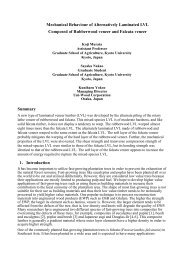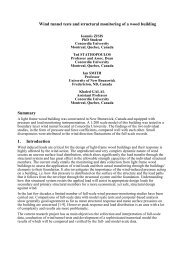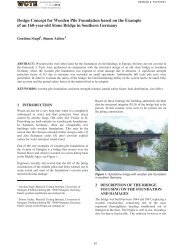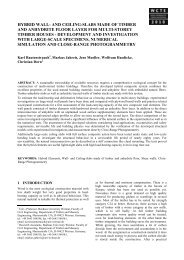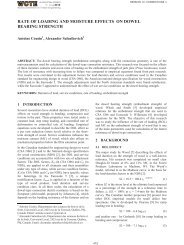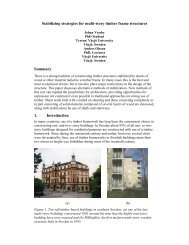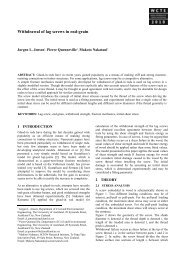Study on the numerical analysis for structural detail of timber frame ...
Study on the numerical analysis for structural detail of timber frame ...
Study on the numerical analysis for structural detail of timber frame ...
You also want an ePaper? Increase the reach of your titles
YUMPU automatically turns print PDFs into web optimized ePapers that Google loves.
Figure 12: Compressive strain inclined to <strong>the</strong> grain<br />
(R00T)<br />
Figure 13: Compressive strain inclined to <strong>the</strong> grain<br />
(R05T)<br />
Figure 14: Compressive strain inclined to <strong>the</strong> grain<br />
(R10T)<br />
3 CROSS-SHAPED FRAME TEST<br />
3.1 EXPERIMENT OUTLINE<br />
In this study, cross-shaped <strong>frame</strong> is made using n<strong>on</strong>-knot<br />
cedar wood with column cross secti<strong>on</strong> 100100mm and<br />
nuki-beam cross secti<strong>on</strong> 40100mm. The column upper<br />
and bottom ends are restricted by <strong>the</strong> pin support as<br />
shown in Figure 15.<br />
Intertru<br />
ss<br />
振れ止め<br />
Load P 1<br />
Disp. 1 Disp. 2 200 200<br />
DG3<br />
DG5<br />
+<br />
-<br />
DG1<br />
50 50<br />
DG7<br />
DG4<br />
100<br />
300<br />
DG6<br />
100<br />
DG8<br />
250 250<br />
500<br />
250 250<br />
300<br />
160<br />
DG10 DG11<br />
DG12 DG13<br />
160<br />
DG9<br />
50<br />
50<br />
200<br />
振れ止め<br />
DG2<br />
Intertru<br />
ss<br />
Load P 2<br />
-<br />
+<br />
Figure 15: Test specimen dimensi<strong>on</strong> and displacement<br />
measurement positi<strong>on</strong><br />
The loading test was carried out by using two electr<strong>on</strong>ic<br />
c<strong>on</strong>trol actuators to applied antisymmetric vertical<br />
displacement <strong>for</strong> <strong>the</strong> nuki beam ends.<br />
Cotter pin<br />
40<br />
60<br />
304030<br />
140<br />
140<br />
2060<br />
20<br />
込栓(15×15) 304030<br />
20<br />
60<br />
40<br />
2060 20<br />
20<br />
くさび Wedge<br />
20<br />
Wedge くさび<br />
Wedge<br />
くさび<br />
Model A<br />
(Complete nuki joint)<br />
Model B<br />
(Link nuki joint)<br />
Model C<br />
(Link nuki joint with cotter pin)<br />
Figure 16: The <strong>detail</strong>s <strong>of</strong> <strong>the</strong> each test specimen juncture<br />
The <strong>frame</strong> models were made 3 types which different <strong>of</strong><br />
<strong>the</strong> joint <strong>detail</strong> as shown in Figure 16. The model A is<br />
complete c<strong>on</strong>tinuous beam joint, and <strong>the</strong> horiz<strong>on</strong>tal beam<br />
member is <strong>on</strong>e part element (it is called complete nuki<br />
joint). Model B is <strong>the</strong> joint processing <strong>the</strong> right and left<br />
members like key-shape, and c<strong>on</strong>sist <strong>of</strong> disc<strong>on</strong>tinues<br />
beam (it is called link nuki joint). Model C is stricken <strong>the</strong><br />
cotter pin to <strong>the</strong> linke nuki joint, and <strong>the</strong> disc<strong>on</strong>tinuous<br />
beam is fixed in <strong>the</strong> c<strong>on</strong>necti<strong>on</strong> inside (it is called link<br />
nuki joint with cotter pin). These joints have also fixed<br />
by driving two wedges (zelkova material) <strong>on</strong> <strong>the</strong> upper<br />
clearance between column and beam. The <strong>detail</strong>s <strong>of</strong> each<br />
part are shown in Figure 16.<br />
The whole view <strong>of</strong> Model A is shown in Figure 17. The<br />
Model A has been bound <strong>the</strong> 1/3 span from <strong>the</strong> edge <strong>of</strong><br />
<strong>the</strong> horiz<strong>on</strong>tal bracing <strong>for</strong> out-<strong>of</strong>-plane de<strong>for</strong>mati<strong>on</strong> by<br />
steel pipes (intertruss braceing) which covered PTFE<br />
sheet to reduce <strong>the</strong> fricti<strong>on</strong>.


